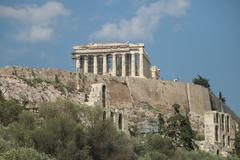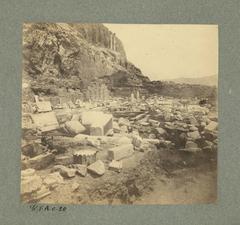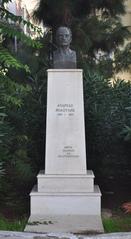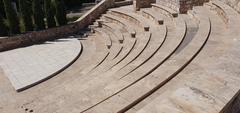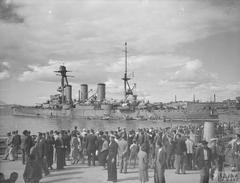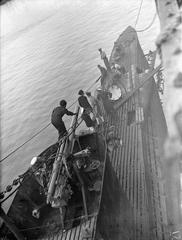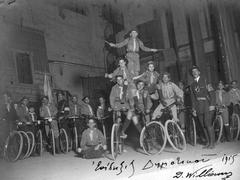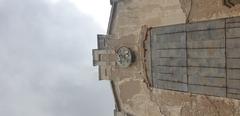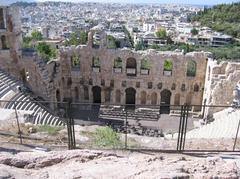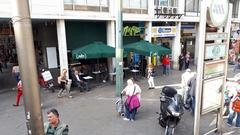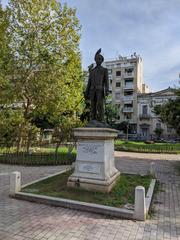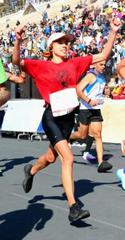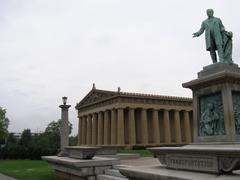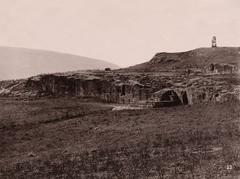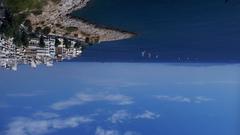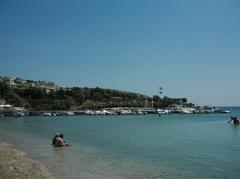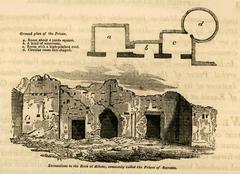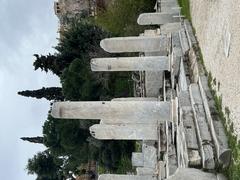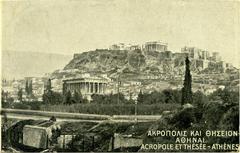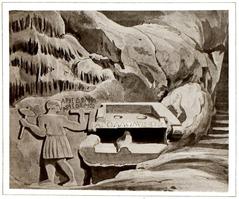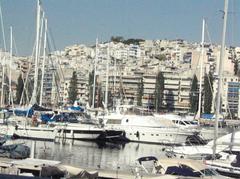Eetioneia, Piraeus, Greece: Visiting Hours, Tickets, and Comprehensive Travel Guide
Date: 14/06/2025
Introduction: Eetioneia’s History and Significance
Eetioneia, perched at the westernmost tip of the Piraeus peninsula, is an ancient fortress representing Piraeus’ enduring maritime legacy and strategic importance in antiquity. Overlooking the entrance to the Great Harbour (Megas Limen) and the Kantharos harbor, Eetioneia’s fortifications were pivotal for controlling naval traffic and safeguarding Athens’ primary port. Initiated by Themistocles in the early 5th century BCE, Eetioneia’s defenses experienced significant reinforcement during key historical periods, notably the Peloponnesian War under the oligarchic Four Hundred. Today, the archaeological site showcases monumental gates, towers, and defensive walls, reflecting the city’s layered history and its ongoing role as a center of commerce and culture. This guide delivers detailed information on visiting Eetioneia, including hours, tickets, accessibility, historical context, and nearby attractions, empowering visitors to explore this essential landmark in Greek history (Sententiae Antiquae, Piraeus.org, Griechenland Zeitung).
Table of Contents
- Introduction
- Historical and Strategic Overview
- Historical Development and Construction
- Archaeological Discoveries and Site Features
- Cultural Significance and Symbolism
- Archaeological Challenges and Research
- Visiting Information: Hours, Tickets & Accessibility
- Travel Tips and Nearby Attractions
- Guided Tours and Interpretation
- Photographic Spots and Special Events
- Safety and Visitor Etiquette
- Getting There and Transportation
- Educational and Interpretive Resources
- Frequently Asked Questions (FAQ)
- Conclusion and Call to Action
- References and Further Reading
Historical and Strategic Overview
Eetioneia (Ηετιώνεια) forms a narrow peninsula at the harbor’s mouth, where its high rocky outcrop and narrow land bridge provided an ideal defensive vantage. Its position adjacent to the Kantharos harbor, along with the natural harbors of Zea and Munichia, made Piraeus the logical choice for Athens’ main port. Control over Eetioneia meant control over all naval movements in and out of the harbor—a critical factor during both peace and war.
Historical Development and Construction
Major urban and defensive developments in Piraeus began under Themistocles after the Persian Wars. Eetioneia’s fortifications, including its monumental gate and walls, were integrated into Athens’ broader Long Walls system. During the Peloponnesian War, the oligarchic Four Hundred fortified Eetioneia further to secure control over the harbor. Over time, these structures were updated to reflect advances in military architecture and evolving threats.
Archaeological Discoveries and Site Features
Systematic excavation since the 19th century has exposed large portions of Eetioneia’s walls, towers, and harbor infrastructure. Notably, the fortress featured a double-doored gate flanked by towers over 10 meters in diameter, a wide defensive trench, and a wooden drawbridge. Recent restoration initiatives, supported by the Greek Ministry of Culture and the EU, have stabilized and illuminated the site, making it accessible to the public and visually striking, especially at night (Griechenland Zeitung).
Cultural Significance and Symbolism
Eetioneia was not solely a military installation—it was integral to Piraeus’ commercial and cosmopolitan life, controlling the movement of people and goods. The site’s mythological associations, such as its naming after the legendary ruler Hetion, reflect the interweaving of legend and history. The Megiste Stoa, a large warehouse near the gate, played a vital role in storing and trading grain, stabilizing Athens’ food supply during critical periods (Sententiae Antiquae).
Archaeological Challenges and Research
Unlike Athens, Piraeus’ ancient topography is more difficult to reconstruct due to sparse ancient references and dense modern development. Early archaeologists faced challenges in interpreting the remains, but newer technologies like GIS mapping have improved understanding of the site’s relationship to the broader city and its harbor infrastructure (Greece Is).
Visiting Information: Hours, Tickets & Accessibility
- Location: Kastraki Hill, Drapetsona district, Piraeus—overlooking the main harbor entrance (Piraeus.org).
- Visiting Hours: Generally open daily from 8:00 AM to 6:00 PM; confirm with local authorities or the Greek Ministry of Culture for seasonal changes.
- Tickets: Entry is free. Guided tours may incur a small fee.
- Accessibility: Recent restorations include pathways and ramps, though some uneven terrain remains. Contact the site in advance for accessibility support.
- Facilities: Limited amenities on-site; nearby cafes and restrooms are available in the port area.
Travel Tips and Nearby Attractions
- Best Time to Visit: Early morning or late afternoon for optimal lighting and cooler temperatures. June is ideal, coinciding with the Maritime Festival.
- Photography: The illuminated fortress walls and panoramic harbor views offer excellent photo opportunities, particularly at sunset.
- Nearby Attractions:
- Archaeological Museum of Piraeus: Features local artifacts and statues.
- Hellenic Maritime Museum: Chronicles Greece’s naval history.
- Mikrolimano Marina: Picturesque harbor with dining options.
- Veakeio Theatre: Open-air venue with summer performances.
- Votsalakia Beach: Piraeus’ largest beach for relaxation (Discover Greece).
Guided Tours and Interpretation
Eetioneia is suitable for self-guided exploration, aided by bilingual signage. Local tour operators and the Archaeological Museum of Piraeus offer guided walks that often include the fortress, harbor, and other historical sites.
Photographic Spots and Special Events
The site’s elevation provides sweeping views of the harbor and city. The annual Maritime Festival in June features boat races, concerts, and exhibitions, enhancing the visitor experience and highlighting the city’s connection to the sea (Overyourplace.com).
Safety and Visitor Etiquette
- Respect the Ruins: Do not climb on ancient walls or remove stones.
- Stay on Paths: Use designated pathways to preserve the site and for personal safety.
- Photography: Permitted and encouraged, particularly in the evening.
Getting There and Transportation
- From Athens:
- Metro Line 1 to Piraeus station, then a short walk, taxi, or bus to Kastraki Hill.
- Alternatively, Metro Line 3 and suburban railway serve Piraeus.
- By Ferry: Walking distance from main ferry terminals.
- By Car: Parking available in Drapetsona; may be limited during peak times (Piraeus.org).
- By Bus: Multiple routes connect central Athens and Piraeus.
Educational and Interpretive Resources
Interpretive signage on-site and educational programs from the Ephorate of Antiquities of West Attica, Piraeus, and the Islands offer context and learning opportunities for both children and adults. The Archaeological Museums Network provides additional educational resources.
Frequently Asked Questions (FAQ)
Q: What are the Eetioneia visiting hours?
A: Open daily, 8:00 AM–6:00 PM, with potential seasonal variations.
Q: Is admission free?
A: Yes, entry is free. Guided tours may require a small fee.
Q: How accessible is the site?
A: Pathways and ramps are available, but some uneven surfaces remain.
Q: Are guided tours available?
A: Yes, through local operators and the Archaeological Museum of Piraeus.
Q: What is the best way to reach Eetioneia?
A: Metro Line 1 or 3 to Piraeus, then walk or take local transport.
Conclusion and Call to Action
Eetioneia is a remarkable testament to Athens’ ancient maritime power and resilience. Its well-preserved fortifications, panoramic views, and proximity to other cultural sites make it a must-visit for travelers seeking to understand Greece’s classical heritage and modern vibrancy. Plan your visit around early morning or evening hours for the best experience, and don’t miss local events like the Maritime Festival. For up-to-date information, interactive maps, and guided audio tours, download the Audiala app and follow official tourism channels.
References and Further Reading
- Sententiae Antiquae: Piraeus Heterotopia
- Greece Is: Exploring the Pocket Ruins of Piraeus
- Piraeus.org: Things to Do and See
- myCityHunt: Eetioneia
- Griechenland Zeitung: Antikes Eetioneia Tor in Piraeus
- Overyourplace.com: Piraeus Culture, History, Traditions, and Festivals Guide
- Discover Greece: 10 Best Things to Do in Piraeus
- Archaeological Museums Network
- Buddy the Traveling Monkey: Things to Do in Piraeus, Greece
- Lonely Planet: Piraeus
- Where and When: Weather in Piraeus in June
